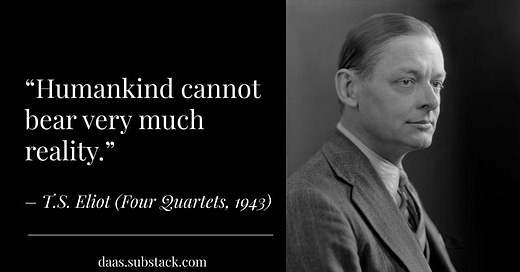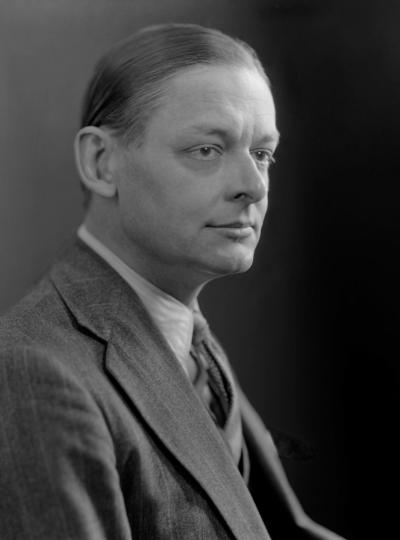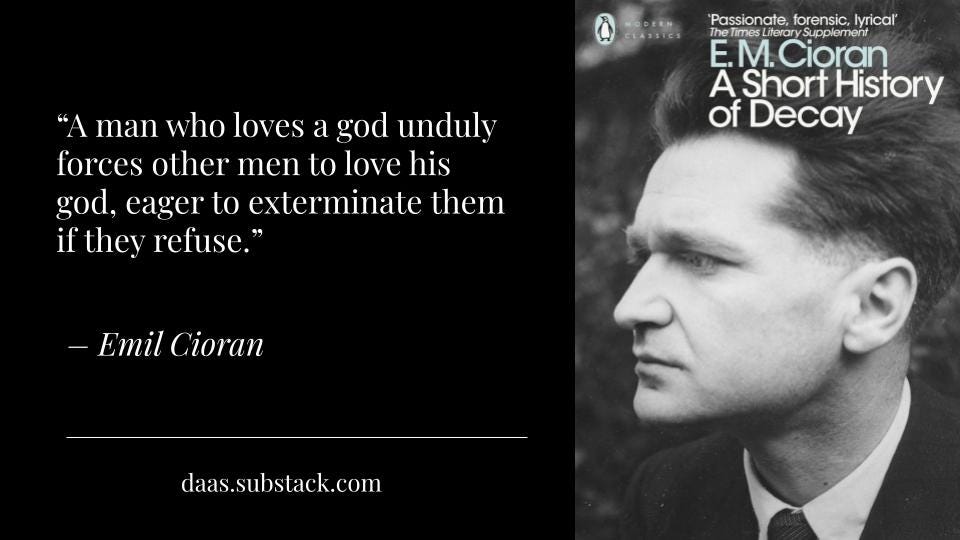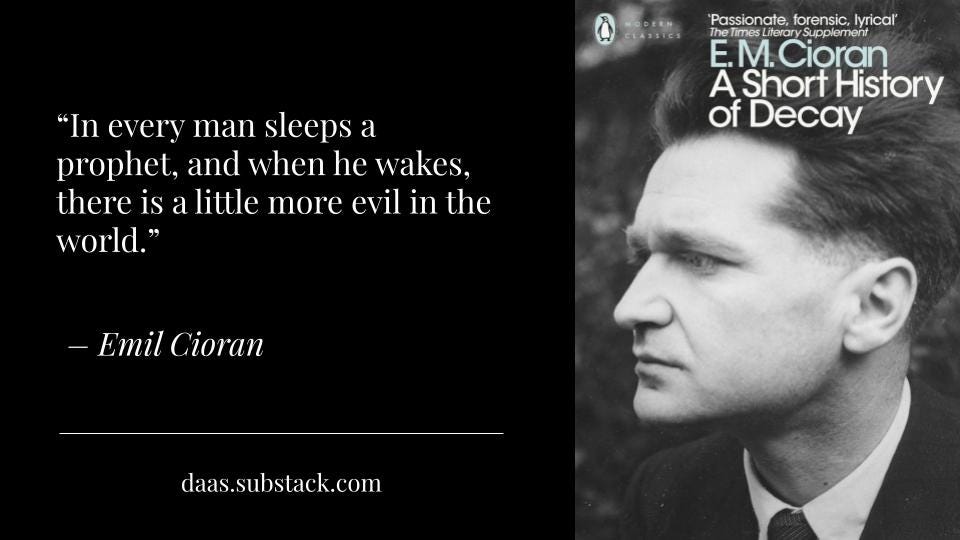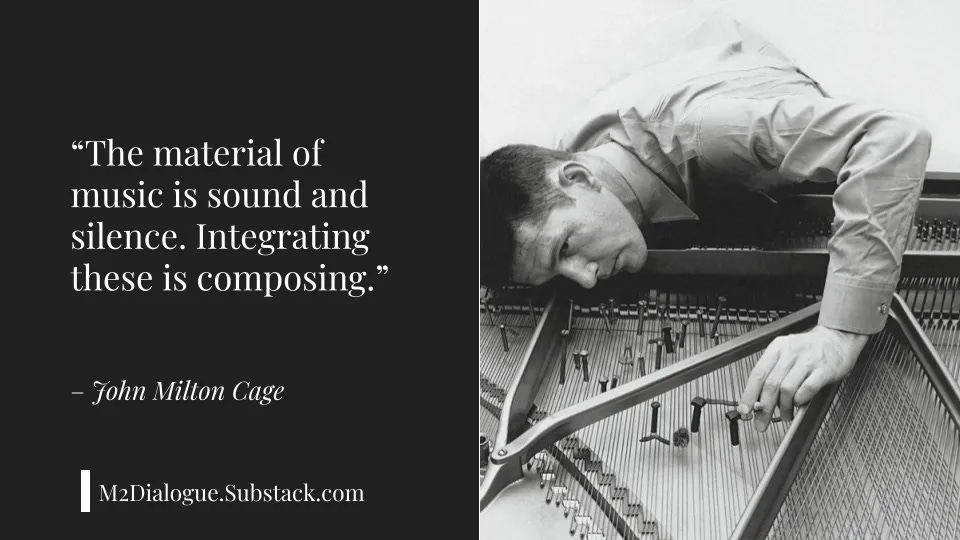In this essay, I explore three survival strategies deployed in response to existential threats. As a springboard for this exploration, I turn to Bird Box, the 2018 film in which a mysterious force elicits three types of responses, which I call Prophecy, Anti-Prophecy, and Realism. If treated as archetypal forms, these responses can illuminate our choices in non-fictional worlds and help us set realistic expectations for dialogue with people employing survival strategies that seem incompatible with ours.
In the film, Prophecy and Anti-Prophecy serve as contrasting ways of not becoming a Realist. When Realists see the mysterious force, they kill themselves. Anti-Prophets survive by not seeing the force – they blindfold themselves. Prophets survive by seeing the force and then evangelizing to convince others that “It's beautiful!” (referring to the force). With this message, Prophets try to convince Anti-Prophets to remove their life-saving blindfolds. Anti-Prophets resist with desperate determination. Below, I offer my reflections on these three responses and their emergence in confrontations with what W.H. Auden called “forces we pretend to understand”.
This is a long read, approximately 4,700 words. To make sure you’re not reading a truncated version in your email, go to M2D. For convenience, I’m also including a print-friendly PDF version of the essay without any images.
To begin, let's acknowledge the limitations of all typologies and models. As John von Neumann wrote:
Truth is much too complicated to allow anything but approximations.
Unlike Bird Box, the approximations below don’t seek to categorize people into mutually exclusive types. In our real-world encounters with poorly understood threats, we all embody aspects of Realists, Prophets and Anti-Prophets. We can all benefit from inhabiting these archetypal forms more consciously.
The Three Strategies
To explore these three strategies, I'll use Bird Box to illustrate the perspective of Anti-Prophets and Realists. For Prophets, I'll turn to Don't Look Up, the 2021 film in which willful ignorance of an impending cataclysm leads to avoidable destruction.
Anti-Prophets
Using Bird Box to examine our responses to existential threats, most of us will probably identify as Anti-Prophets. Like Malorie Hayes (Sandra Bullock), we require no explanation for the logic of survival through avoidance, or ‘blindness’. We are determined to resist the fervent evangelism of our antagonists. They are possessed, and we cannot reason with them. Dialogue is not an option. If we allow ourselves to be influenced by them, we die.
In reality, this death may take the form of loss of life or loss of self. Whether the effect of Prophecy is physical or non-physical, death is only rarely the result of our interactions with Prophets. In most of these interactions, we only receive non-lethal doses of their venom, and we may metabolize them within hours, days, or years. However, whether the dose is high or low, the delivery mechanism is typically an epistemic power grab – an attempt to substitute the Prophet’s worldview for ours. The Prophet is a parasite.
In Second-Order Ignorance (SOI): Learning to See the Problem,1 I mentioned numerous categories of real-life Prophets (aka “Blind Gropers”), but I also warned readers against obsessing over specific examples. Instead, I urged them to notice “transcontextual patterns of corruption” that characterize modern-day Prophets, including merchants of snake oil and messianic hope. Here, I simply want to point to two sources that elucidate our emotional responses to encounters with Prophets.
First, Emil Cioran focuses on the interlacing themes of Prophecy and Anti-Prophecy in several of his works, particularly A Short History of Decay.2 In a chapter titled “The Genealogy of Fanaticism”, Cioran writes:
“A man who loves a god unduly forces other men to love his god, eager to exterminate them if they refuse. There is no form of intolerance, of proselytism or ideological intransigence which fails to reveal the bestial substratum of enthusiasm. Once man loses his faculty of indifference, he becomes a potential murderer; once he transforms his idea into a god, the consequences are incalculable.”
Without even reading Cioran, many people know or intuit that, as Cioran writes: “In every man, sleeps a prophet, and when he wakes, there is a little more evil in the world…The compulsion to preach is so rooted in us that it emerges from depths unknown to the instinct for self-preservation.”
The second source is the philosopher L.A. Paul whose insights into interactions with Prophets come through a thought experiment. In lectures like this one, she imagines a conversation in which a vampire delivers a sales pitch:
“Imagine that you had a one-time-only chance to become a vampire. With one swift and painless bite, you’ll be permanently transformed into an elegant and fabulous creature of the night. As a member of the undead, your life will be completely different. You'll experience a range of intense new sense experiences. You'll gain immortal strength, speed and power. And you will look fantastic in black.
Now, there are negatives. You'll have to drink blood. Maybe human blood. Or maybe artificially constructed blood. But you will find it delicious. You'll have to avoid sunlight, and you'll have to sleep in a coffin.
Now suppose that all of your friends — people whose interests, views and lives are similar to yours — have already decided to become vampires. And most of them tell you that they love it. They describe their new lives with unbridled enthusiasm and encourage you to become a vampire too. They say things like ‘Look, life has meaning and a sense of purpose now that it never had when I was human.’ And they go on enthusiastically and tell you how wonderful it is.
However, when you press them for more information, they say: ‘Well, I can’t really explain it to you. You’re just a human. You have to become a vampire to understand what it’s like.’
The question is "would you do it?”
Cioran and Paul, taken together, highlight an important difference between the story in Bird Box and our real-life interactions with Prophets. IRL, we don’t just respond to Prophets with mortal terror or disgust (although sometimes we do). By far, the most common responses to Prophets are attraction, fascination, and enthusiasm. That helps explain why Prophets run our world, why they dominate politics and culture, and why they own the means of production for the opium of the masses. We don’t see this reality reflected in Bird Box. What Bird Box does reflect is our intuition that the idea of dialogue with Prophets is laughable. What we need in our interactions with Prophets isn’t dialogue but distance.
For further exploration of the Anti-Prophet's perspective, consider A Beautiful Life, the 1997 film that memorably dramatized the life-saving potential of willful ignorance. Here and in Bird Box, parents save their children by helping them not see the horror around them. Not seeing represents a form of life-saving compassion for the limits of psychic resilience.
Prophets
Shifting perspective, let's examine the Prophet archetype through the lens of Don't Look Up, the 2021 film in which the choice to ignore an existential threat appears as a fundamental denial of reality. Like Dr. Randall Mindy (Leonardo DiCaprio), we witness the dominant majority's willful ignorance as a path to collective destruction.
As Prophets, we can quote Cioran and L.A. Paul as eagerly as Anti-Prophets do. We recognize that “the compulsion to preach is so rooted in us that it emerges from depths unknown to the instinct for self-preservation.” We, too, hope that people learn to think clearly and respond wisely to the allure of transformative experiences. We hope that people learn to see the nature of the agreements they form with Prophets in daily life, including Prophets appearing as vampires with a sales pitch.
In our interactions with Anti-Prophets, our mission is simple: we must awaken the somnambulists. These sleepwalkers may appear to be awake and in charge, but we know that they’re asleep and helplessly spiraling into avoidable destruction.
We value dialogue, and we seek the attention of Anti-Prophets, but they constantly accuse us of perverting dialogue with our ‘missionary zeal’. They insult us. They call us doomers, or merchants of snake oil or hopium or copium. Despite these insults, we remain open to dialogue. However, until the Anti-Prophets wake up — until they look up and dare to see the comet hurtling toward our planet — true dialogue will remain impossible.
To awaken Anti-Prophets, we may employ any means necessary, including persuasion, charm, and even deception. Our mission supersedes social norms and individual preferences. We may forgive Anti-Prophets for they know not what they do, but we must wake them up before we can talk to them as conscious humans. We’re not just trying to save them; we’re trying to save our shared world.
Anti-Prophets may pathologize our urgency as fanaticism, but our message remains: ‘Wake up!' Willful ignorance jeopardizes our collective future.’
Prophecy is an ancient calling, but I often recommend a relatively recent exploration of the Prophet's perspective – Edgar Allan Poe's A Descent Into the Maelstrom (1841), a story of survival through observation. The three brothers in the story confront an ineffable force, and their default responses to this confrontation result in death, either through incapacity or insanity. As Marshall McLuhan has argued, the road less traveled begins with our “willingness to contemplate what is happening”. If we dare to know, as the surviving brother did, nothing is predetermined.
On Substack, this short story inspired Andrew McLuhan's five-part series on ‘Maelstrom Escape Strategies’.3 In the preface to Part 1, Andrew picks up where his father and grandfather left off. He writes:
I set out to take metaphors literally, and literal things metaphorically, in keeping with the McLuhan tradition. I thought, ‘OK, Marshall, we're drowning in it. If we were already pretty far gone in the 60s and 70s, we're all but lost now’. I figured what we needed was non-metaphorical ways of getting out. Things that we all can do, because it's late in the game and no help seems to be coming from those we might expect to be giving it.
To discover these non-metaphorical ways, we must remember what Marshall McLuhan wrote in a letter to Life Magazine on March 1, 1966:
Determinism is the result of the behavior of those determined to ignore what is happening around them. Recognition of the psychic and social effects of technological change makes it possible to neutralize the effects of innovation.
When innovation moves at the speed of light while regulation moves at the speed of paper, we can't look to ‘regulators’ for our maelstrom escape strategies. Instead, we must seize the means of perception.
Realists
To explore the Realist archetype, let's return to Bird Box because there are no Realists in Don't Look Up, at least until the comet hits and everyone becomes a Realist. But in Bird Box, Realists feature prominently. Unlike Prophets, who evangelize on behalf of the force, or Anti-Prophets, who avoid the force, Realists succumb to its overwhelming power, embodying a state neither group desires.
Because both Prophets and Anti-Prophets fear death, they perceive the Realist’s death as a loss. Anti-Prophets avoid this loss through willful ignorance, Prophets through fanaticism. By contrast, Realists paradoxically survive by not surviving. Thus, they embody a truth beyond the comprehension of the other archetypes.
Examples of Realists abound in stories of martyrs who value truth and justice more than they value self-preservation. While they may resemble Prophets in their unwavering commitment, there's a crucial distinction: Prophets articulate their truth, whereas martyrs, recognizing the limits of language, embody their truth through their action and non-action. Once they realize the futility of sound, silence becomes their message and medium.
Some of them manage to amplify the sound of silence as the composer John Cage did in his famous composition 4’33”. As an example of prevailing perceptions of such works of art, 4’33” serves as Exhibit B in Lewis Mumford’s essay “The Cult of Anti-Life”, published in VQR in 1970. Here, Mumford writes that this cult encompasses a “mass of purposeful irrationality, paranoid inflation, cultivated idiocy, and mindless destruction.” In addition to 4’33”, Mumford highlights four examples of the anti-life aesthetic. My personal favorite is Exhibit A:
“An orchestral concert, held in a hall where music is usually performed. The members of the orchestra take their seats. One of them begins to saw a violin in two. Others follow suit with axes. Loud noises, electronically produced, accompany this performance. In the end nothing is left. The audience that has tolerated these insults has allegedly participated in the “new music,” while those who have indignantly left the hall have, by their justifiable anger or contempt, testified to the success of the anti-musicians.”
According to Mumford, each of the exhibits illustrates “a preference for ‘going with’ the forces of disintegration by joining the licensed madmen in their antics.” And:
“This cultural nihilism, which began as a reaction against regimentation, has become in turn a mode of counter-regimentation, with its ritualized destruction and its denial of all the cultural processes that have sublimated man’s irrational impulses and released his creative energies. Anti-art offers total extermination as the “final solution” for an over-organized civilization.”
Similar to members of the ‘Cult of Anti-Life’ who exhibit a preference for “going with” the forces of disintegration, the Realists in Bird Box yield to the forces devastating their world. Unlike the members of the Cult, Realists never become what they bemoan…because they die. Death is their path to survival.
This distinction is consistent with Mumford's critique of anti-art. He doesn't fault Dada for going too far, but for not going far enough, for failing to practice what it preaches, to the point of self-annihilation. Mumford cites Louis Aragon's formulation of the program for anti-art in the declaration of Dada:
“No more painters, no more writers, no more musicians, no more sculptors, no more religious, no more republicans, no more royalists, no more imperialists, no more anarchists, no more socialists, no more bolsheviks, no more politicians, no more proletarians, no more democrats, no more bourgeois, no more aristocrats, no more armies, no more police, no more fatherlands; enough of all these imbecilities: no more of anything, nothing at all: NOTHING, NOTHING NOTHING.”
Mumford adds:
“Only one thing was curiously lacking in this total denial: NO MORE DADA. Dada refused to obey its own original credo–– “All true Dada’s are anti-Dada.”
Bird’s Eye View of ‘Bird Box’
Beyond Good and Evil
Interestingly, Mumford's critique sheds light not only on Realism but also on Prophecy and Anti-Prophecy. These responses to the horror of the Unknown are beyond good and evil, in the sense that they all make both positive and negative contributions to collective sensemaking in times of uncertainty and elevated existential risk. However, these archetypal forms all fall short of their potential not when they express themselves too assertively, but when they express themselves dishonestly and inconsistently.
First, here's a sketch of each archetype's positive and negative expressions:
Prophets: Having seen the mysterious force and lived to tell the tale, Prophets help us echolocate the path to survival with their uncommon perceptions. They are the most advanced students of the present moment. Historically, their work marks the beginning of self-critical thinking.4 The problem is that organized religion has often portrayed these savants as futurists, and modern culture rewards them for ‘propheteering’. People turning to Prophets today mostly find fraudsters and fanatics with poor boundaries and compromised reality testing. Overall, Prophets are not of this world, which is why this world doesn’t know what to do with them. Sometimes the world institutionalizes them; sometimes, it elevates them to positions of great power.
Anti-Prophets: Discernment and skepticism are the chief virtues of Anti-Prophets. Through encounters with Prophets, they developed a forensic mindset. Whether they confront a prophet of doom or a merchant of messianic hope, they respond with the presumption of guilt. They have a wary sixth sense for absolutists incapable of metabolizing doubt. This mindset often protects Anti-Prophets from unspeakable harm. The problem is that this mindset can also mirror the Prophet’s fanaticism by blinding Anti-Prophets to the brokenness of our world and the opportunities for its repair. Anti-Prophets often feel that Prophets run the world, but they don't see that survival through ignorance is the dominant ideology among power elites.
Realists: In its positive expression, the Realist’s acceptance of existential threats as aspects of reality takes the form of dispassion. In its negative expression, this acceptance takes the form of passivity or indifference. Whether the acceptance takes a positive or negative form, both Prophets and Anti-Prophets regard the Realist with incomprehension. They see in the Realist a quality they find lacking in themselves: courage. They see that the Realist responds with acceptance to the same force that drives them into fear-fueled responses.
With a clear potential for both positive and negative expressions of their archetypal forms, Prophets, Anti-Prophets and Realists can favorably tilt the balance by following this simple rule: Don't lie; Don't be a hypocrite.
Prophets: Most Prophets are simply faking it. They're either false prophets or the foolish prophets described in Ezekiel 13:3 who “follow their own spirits but have seen nothing.” Some Prophets are also hypocrites: they do not treat other Prophets the way they themselves wish to be treated.
Anti-Prophets: The lie at the heart of most Anti-Prophecy is that it's primarily motivated by the knowledge that most Prophets are full of shit. In reality, most Anti-Prophets are simply well-served by the status quo, and they have every incentive to deny the brokenness of our world and the opportunities for its repair. Most Anti-Prophets are Denialists.5
Realists: Even more than the other two archetypes, Realists are defined by the degree to which they practice what they preach. Just as Realists see through the futility of the Anti-Prophet's denialism and the Prophet's fanaticism, they must also see the incompleteness of their own surrender and dispassion. Otherwise, they risk becoming self-parodies.
Prophets vs. Anti-Prophets
I’ve heard this teaching from countless Prophets and Anti-prophets: We don’t see the world as it is; we see it as we are. With time, the idea seems increasingly imprecise to me. We certainly don’t see the world as it is, but do we really have enough self-knowledge or courage, either personally or collectively, to see the world as we are?
It seems at least closer to the truth to say that we see ourselves and the world as we want to be, which may help explain the impossibility of dialogue between Prophets and Anti-Prophets. Whether we find ourselves in the role of the former or the latter, we see the other side trying to use our energy to fulfill its own desires. No wonder we can’t stand each other.
I compare the relationship between Prophets and Anti-Prophets to a cold war. Dialogue between us is impossible, but so is divorce. So, we’re stuck in the same global village, and the quest for identity increasingly pushes us into violence. Instead of dialogue, we engage in simulations and perversions of dialogue. This sounds bad, but perhaps this is how we prevent the cold war from turning hot. Ironically, this may be how we are jointly saving the world.
Realists vs. Everyone
Through the fog of hope and fear,
The path to salvation now seems stunningly clear:
Abandon all hope ye who enter here.
And abandon all fear, my dear.
Realists do not delude themselves either with fear or hope. They are not drawn to any location on the Optimism-Pessimism Spectrum (OPS). They do not get excited about the lesser evil. They do not seek to replace one bankrupt ideology with another whose bankruptcy has not yet become self-evident.
While Anti-Prophets reject Prophets, Realists reject everyone. While Prophets strain to overcome the resistance of Anti-Prophets, Realists recognize all resistance and all ‘overcoming’ as errors of their wayward youth. They live like the river flows.
Realists don’t need to read Lewis Mumford’s critique of Dada to know that a proclaimed adherence to “none of the above” can easily turn into tacit commitment to “one of the above”; the rejection of the given options can become one of the options. Dissent can become just another performative stance.
When Realists say “none of the above”, they mean it. Whatever others think that means, that's part of what it doesn't mean. Realists are not appeased by the option to check a box marked “none of the above”; they’re more inclined to tear up the menu of allowable responses.
Realists accept the consequences of their orientation. The clearest consequence is that it leaves them without a tribe. Prophets and Anti-Prophets dread tribelessness. Realists see it as the only way forward.
Realists are the opposite of delusional thinkers who always win simply by never conceding defeat. After the first burning of books by Nazis, Joseph Roth wrote an essay titled “The Auto-da-Fé of the Mind” where he urged fellow Jewish writers to accept that they had been vanquished:6
“Let us, who were fighting on the front line, under the banner of the European mind, let us fulfill the noblest duty of the defeated warrior: Let us concede our defeat.”
“What use are my words against the guns, the loudspeakers, the murderers, the deranged ministers, the stupid interviewers and journalists who interpret the voice of this world of Babel, muddied anyhow, via the drums of Nuremberg?”
Roth wrote to Stefan Zweig:
“It will become clear to you now that we are heading for a great catastrophe. The barbarians have taken over. Do not deceive yourself. Hell reigns.”
But Roth also argued that, even if defeat is certain, resistance is a moral imperative, a way to defend one’s dignity and the sanctity of the truth:
“One must write, even when one realizes the printed word can no longer improve anything.”
Perhaps, this last quote reveals the incompleteness of Roth’s surrender. A more committed Realist might be equally at peace with not writing. But no Realist is fully committed to any ideology, not even Realism. Realists are fully human.
Can We Do Better?
Perhaps, But…
The psychoanalyst Otto Rank wrote: “There is already too much truth in the world - an overproduction which apparently cannot be consumed!” Despite the hyper-acceleration of this over-production, we see no evidence of a commensurate increase in the human ability to metabolize this elixir.
In defiance of this growing imbalance, we continue to produce and consume the remedy that’s supposed to save the world and set us free. The result is an infobese humanity, and infobesity kills minds as surely as obesity kills bodies. Whether the elixir turns out to be snake oil or poison, it’s a case study in iatrogenic harm. In the words of Joseph Roth, “the printed word can no longer improve anything.” Perhaps we can somehow do better, but we appear to be spiraling toward something worse.
The Open Secret
It’s ironic that this spiral continues to tighten even though we have long known the way to break the pattern. It’s an open secret that I first sketched out in Self vs. Self: Learning to See the Impossible War. Due to my online research for this modest contribution to the overproduction of truth, the Almighty Algorithm has increased the frequency with which it recommends to me sources that raise some form of this familiar question: How do entire societies go mad?
The problem with most answers to any version of this question is that they regurgitate existing sources into finely crafted content that hooks into the vulnerabilities of anxiety-ridden minds. This video by Mr. Brain may be no exception, but it serves as an adequate introduction to the subject of psychic epidemics or mass psychosis.
One of the problems with merely adequate introductions to the subject is that they typically fail to penetrate a powerful defense that academic psychologists call Identity-Protective Cognition (IPC). More informally, we can call it the my-side bias. At the collective scale, this bias helps explain the recent resurgence of tribalism.
For people employing this defense, there’s a simple answer to questions about why entire societies go mad: they go mad because of “them”, the designated “others”. The solution is to identify them and to control, convert or eliminate them.
Breaking the Spell
Before I conclude, let me share an alternative answer to the question about why societies go mad: They go mad because they get colonized by toxic memes that we mistakenly regard as “religions”.7 Etymologically, the idea of religion suggests a reconnection with reality, but these toxic memes are idolatrous technologies of disconnection. They produce madness, which can persist ad infinitum simply because breaking the spell requires us to discover what we are culturally programmed to deny. As Carl Jung wrote in Visions: Notes on a Seminar Given in 1930–1934:
“Modern people have forgotten what man really is, so we have people like Nietzsche and Freud and Adler who tell us what we are, quite mercilessly. We have to discover our Shadow. Otherwise, we are driven to a world war in order to discover what beasts we are.”
Similarly, in Terror in the Name of God: Why Religious Militants Kill, Jessica Stern quotes from Kathleen Norris’s Native Evil:
“Any creative encounter with evil requires that we not distance ourselves from it by simply demonizing those who commit evil acts. In order to write about evil, a writer has to try to comprehend it, from the inside out; to understand the perpetrators and not necessarily sympathize with them. But Americans seem to have a very difficult time recognizing that there is a distinction between understanding and sympathizing. Somehow we believe that an attempt to inform ourselves about what leads to evil is an attempt to explain it away. I believe that just the opposite is true, and that when it comes to coping with evil, ignorance is our worst enemy.”
Mark of Sanity: A Response to Normal Madness
To conclude this essay, I’d like to return to the M2D tradition of naming the problem, naming the remedy and naming the price. Reb Nachman of Breslov, the great-grandson of the founder of Hasidic Judaism, described both the problem and the remedy through the parable of tainted wheat. As told by Rabbi Rami in A Mark of Sanity:
“Upon discovering that the country’s wheat harvest was tainted by a nearly undetectable fungus that would drive the people insane once consumed, the royal astrologer informed the ruler. “There isn’t enough wheat left from the last harvest to avert famine,” the ruler said. “Without this infected crop, the people will starve. What can we do?”
The astrologer advised that they should survive on the remains of the untainted wheat while the rest of the country descends into madness. The ruler objected, saying, “If we do that, our sanity will seem like insanity to the people, and they will turn against us. Instead, we must also consume the tainted wheat. But before we do, let’s wear a mark to remind ourselves that we are insane.”
What is the tainted wheat of our time? What is it that activates the protective instincts of the Prophet, the Anti-Prophet and the Realist? I prefer not to waste words on descriptions and definitions of what we can all sense. Regardless of how we apply Reb Nachman's parable to our lived reality, we know that the tainted wheat of our time is driving us insane, and clinging to sanity is yesterday’s game. Today, it’s a form of denial. Untruth has flooded our world, and it is inimical to sanity. Who among us can claim to be untouched by this devastation of our epistemic order? Who can claim to be an observer and not a participant in the ambient madness? The remedy for insanity isn’t a return to sanity but a deepening of our self-awareness.
For Rabbi Rami, the price of this remedy is the price of a bronze bushel of wheat lapel pin. The price can be even lower, but the personal cost is tremendous because the “Mark of Sanity” marks the end of ideology. It marks the collapse of Life Inside Isms. It also serves as our connection to Reality.
Find your Mark of Sanity. Stay connected.
Housekeeping
With the publication of Make Yourself an Ark, I removed paywalls from all my blogs. My published work is free. If you’d like to hire me, please subscribe to my professional blog and book a complimentary consultation.
In hindsight, SOI was my Anti-Prophet manifesto, written from a transcontextual perspective. I avoided context-specific critiques to overcome information overload and to formulate meta-principles applicable to specific contexts. Still, the essay weighs in at about 9,000 words.
Cioran, Emil. A Short History of Decay. Penguin Classics. 2010
Source: The Way of the Prophet, lecture by Richard Rohr
For an introduction to Denialism, see Four Questions: Responses from the Ark
Source: Chris Hedges Report, 2/23/2025
For related posts, see Toxic Memes, Breaking the Spell

